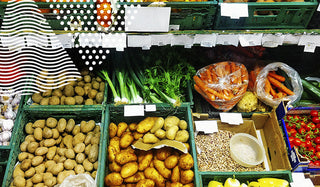In the first of a series of posts looking at each element of the Dineamic Healthy Eating Plate, leading Australian sports dietician, Karen Inge, talks vegetables. Eating more vegetables is the single most important dietary change needed to keep us in good shape and good health. So, are we chomping away on every known vegetable on earth, since they promise us a healthier life? Sadly no. Results from the latest National Nutrition Survey 2011-2012 showed that only 6.8 % of Australians eat the recommended 5 serves of vegetables a day (1 serve = . cup). Let’s put that another way. More than 93% of us are not eating enough vegetables. Vegetables have a very high nutrient density (the amount of essential nutrients relative to kilojoules) and contain more than 900 different phytochemicals (such as antioxidants, flavonoids, carotenoids, sulphur compounds, polyphenols), besides vitamins, minerals and dietary fibre. The fabulous colours of the vegetables themselves are powerful phyto-nutrients that help protect our bodies against free radical damage and offer health benefits. Here are 5 reasons why we need to eat more 1. Heart health There’s a strong relationship between high vegetable consumption and heart health. In a meta -analysis of 12 studies that tracked around 278,000 people for 11 years, those who ate more than 3 serves a day had a better chance of keeping their heart working well than those who only had less than 1.7 serves a day. It may well be that healthier people overall eat more vegetables or it may be due to the fact that eating more fruits and vegetables makes your arteries less stiff and more flexible. Many vegies are a great source of folate like spinach, broccoli, dark lettuces and asparagus to name a few and we know helps to keep blood pressure in check. 2. Vegetables are a good source of potassium and to keep our blood pressure in check we need to have a healthy weight, be physically active and watch our salt (sodium ) intake. Eating more high potassium vegetables like sweet potato, green leafy like spinach and mushrooms can counter the effects of sodium. So when you cook them try not to use too much salt. 3. Great for keeping us in shape. Vegetables in general have a very high water content, especially the non starchy varieties like green beans, snow peas, cauliflower, broccoli, Brussels sprouts, cabbage, green leafy and salad vegies. They are low in kilojoules, a great fibre source and really help to fill you up when you are trying to prevent the kilo creep. So add more vegetables to your meal or enjoy them raw as a crunchy snack 4. Keep those eyes sparkling. Green leafy vegetables like kale, spinach, broccoli, in fact all the green vegetables are rich in lutein and zeaxanthin which are the main carotenoids in the lens of the eye. The retina of the eye also contains lutein. To help keep our eyes seeing clearly it’s important to eat more greens. That’s not so hard to see is it? 5. Taste delish. There are so many different vegetables and so many ways to enjoy them. It’s hard to understand when people say they don’t like vegetables because there is such a variety and they all taste different. Some people are unsure how to prepare vegetables in a delicious way as they don’t come with cooking instructions (apart from frozen ones). Hopefully our Dineamic meals give you some ideas and show you how healthy food can taste great.
Article written by Karen Inge


